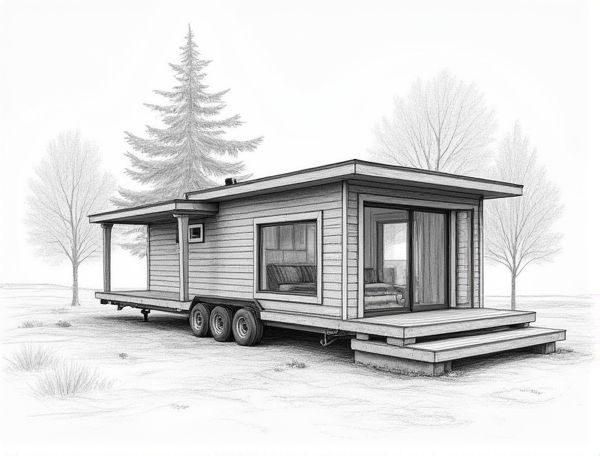
Photo illustration: Tiny home design with integrated off-grid systems
Maximize your tiny home's efficiency by incorporating integrated off-grid systems such as solar panels, rainwater harvesting, and composting toilets, which reduce reliance on external utilities while promoting sustainable living. Explore innovative design ideas and practical tips to create a self-sufficient tiny home by reading more in the article.
Introduction to Tiny Homes with Off-Grid Integration
Tiny homes with off-grid integration offer a sustainable and efficient living solution by combining compact design with renewable energy sources such as solar panels and rainwater harvesting systems. These self-sufficient dwellings reduce utility costs and minimize environmental impact while maximizing functional space through smart planning and multi-purpose furniture. Your transition to an off-grid tiny home can enhance independence and promote an eco-friendly lifestyle without sacrificing comfort.
Key Benefits of Off-Grid Tiny Home Living
Off-grid tiny home living significantly reduces utility costs by eliminating dependence on municipal services through solar, wind, or hydro power systems. This lifestyle promotes environmental sustainability by minimizing carbon footprints and encouraging the use of renewable energy and rainwater harvesting techniques. Enhanced mobility and minimalistic living space foster greater financial freedom and adaptability, making tiny homes ideal for eco-conscious individuals seeking independence and simplicity.
Space-Saving Architectural Design Strategies
Space-saving architectural design strategies integrate multifunctional furniture and built-in storage solutions to maximize usable areas in compact homes. Utilizing vertical space with wall-mounted shelves and loft beds optimizes floor plans while maintaining aesthetic appeal. Innovative layouts such as open-concept rooms and foldable partitions enhance flexibility without compromising spatial comfort.
Efficient Solar Power Solutions for Tiny Homes
Efficient solar power solutions for tiny homes involve integrating high-efficiency photovoltaic panels with compact energy storage systems tailored to limited space constraints, optimizing your off-grid energy independence. Advanced charge controllers and energy management apps ensure maximum power utilization while maintaining sustainability and reducing your carbon footprint.
Water Collection and Filtration Systems
Water collection and filtration systems in home design enhance sustainability by harvesting rainwater through gutters and storage tanks, then purifying it with multi-stage filters including sediment, carbon, and UV purification units. Integrating these systems reduces reliance on municipal water, supports irrigation, and ensures safe, clean water for household use, optimizing resource efficiency and environmental impact.
Composting Toilets and Waste Management
Composting toilets offer an eco-friendly waste management solution by converting human waste into nutrient-rich compost through aerobic decomposition, reducing water usage and minimizing environmental impact. These systems promote sustainable home design by efficiently managing waste onsite, lowering dependence on sewer infrastructure and enabling closed-loop nutrient recycling.
Off-Grid Heating and Cooling Options
Off-grid heating and cooling options include solar-powered heat pumps, wood stoves with thermal mass, and geothermal systems that operate independently from traditional electrical grids. Passive solar design utilizes building orientation, insulation, and thermal windows to naturally regulate indoor temperature without mechanical systems. Energy-efficient ventilation systems like heat recovery ventilators (HRVs) reduce energy consumption while maintaining indoor air quality in off-grid homes.
Smart Storage and Multipurpose Furniture Ideas
Smart storage solutions maximize space efficiency by incorporating built-in shelves, under-bed drawers, and wall-mounted cabinets, ideal for small or open-concept homes. Multipurpose furniture such as sofa beds, extendable dining tables, and ottomans with hidden compartments enhances functionality without sacrificing style. These design choices optimize room utility while maintaining a clutter-free, aesthetically pleasing environment.
Sustainable Building Materials and Insulation
Sustainable building materials such as bamboo, reclaimed wood, and recycled metal reduce environmental impact while enhancing energy efficiency in home design. High-performance insulation materials like cellulose, sheep's wool, and aerogel improve thermal regulation, lower energy consumption, and contribute to healthier indoor air quality.
Planning for Maintenance and Long-Term Self-Sufficiency
Planning for maintenance and long-term self-sufficiency in home designing involves selecting durable materials and incorporating energy-efficient systems such as solar panels and rainwater harvesting. You can reduce future repair costs and environmental impact by designing with sustainable features that support independent operation and easy upkeep.
 homedesy.com
homedesy.com